 |
|
Fountain of The Sun, Rastau, The Missing Portion of the Ancient Egyptian Religion
facebook page
Published: Jun. 24, 2016 (Last Updated: May. 18, 2020)
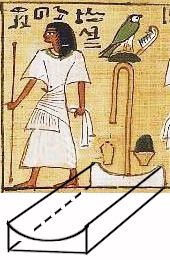 Ancient Egypt had two famous fountains of water, mentioned by some Greek historians, each is called Fountain of the Sun, one was in the ancient Heliopolis and the other was in Siwa Oasis. Since the name of the fountain points to a relation with the god (the sun), it is expected to see some words about it in the Book of the Dead, but nothing is there! Sir Wallis Budge compiled a dictionary of hieroglyphic words, but there is no single word about it can be found anywhere in the whole dictionary! Does that mean the ancient Egyptians had nothing to say about it? In fact it is there in the Egyptian literature, and it is a major part of their religion, but its hieroglyphic symbol was incorrectly interpreted!  Fountain of the Sun
This symbol
The difference between the two symbols
Below is a photo of the fountain of the sun that is existing now in Amun's temple at Siwa Oasis. 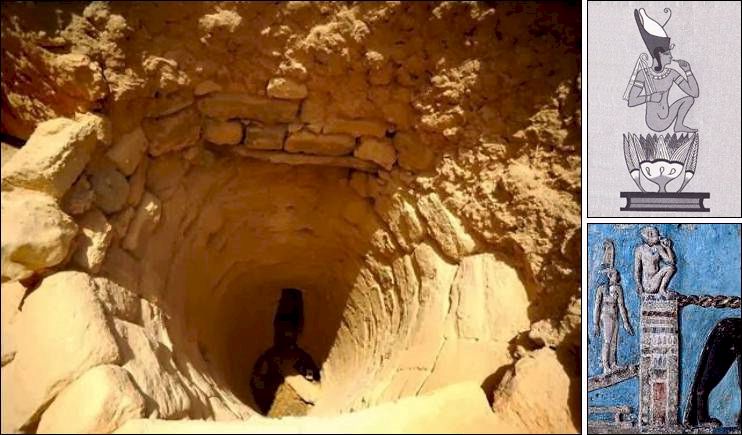
Left: The fountain of the sun at Amun's Temple at Siwa Oasis.
Right: The baby Horus is born from a lotus flower planted inside the fountain of the sun.
By looking at the picture of the fountain above we can see that
extra rocks have been added to the upper part of it; may be to
prevent sand from falling inside; but if the extra rocks were
removed, the curve
There is a dark rectangle carved on the internal wall at the bottom of this hole. It seems that they made what looks like a door or entrance, in the direction of the water flow, to imitate their belief in the night journey, something similar to the door on the rounded object in the blue picture above.
The first picture to the right shows a man and a woman raising hands in greeting to the morning sun
as he is born from a curved object. The second picture shows the scribe Ani standing near the
curved object. This object
Interpreting these two symbols
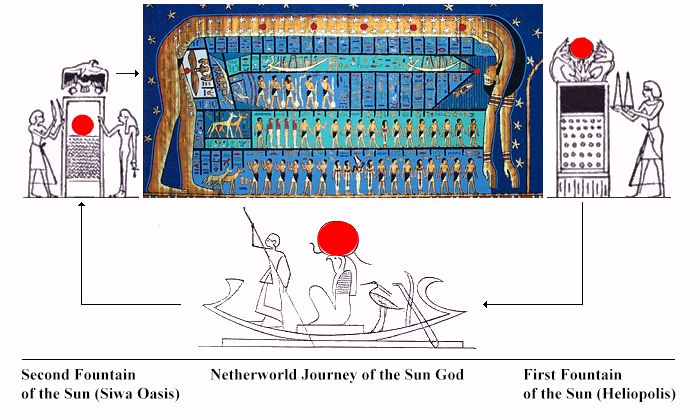 The sky goddess Nut swallows the sun's disk at sunset; the spirit of the disk goes to the netherworld
The sun's disk is swallowed by the sky goddess Nut after sunset. The spirit of the disk, the sun god Ra, goes to the netherworld. He enters the netherworld from a blue lotus flower planted inside the fountain of the sun of Heliopolis when the flower sinks under water in the evening, and he is born in the morning from a lotus flower planted in the fountain of the sun of Amenta (Siwa Oasis), inside the courtyard of Amun's temple when the flower rises from water at dawn; and then he flies to unite with the sun's disk that is born by the sky goddess Nut. What applies to the god, applies also to the dead people who travel with him in his boat, and every dead person uses a separate lotus flower, with the exception that the dead people do not fly to unite with the sun's disk. Ancient Egypt had two types of lotus flowers, blue and white; the blue lotus sinks under water at sunset and rises from water at dawn, while the white lotus sinks under water at dawn and rises from it at sunset. 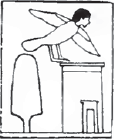 The Fountain of the
Sun of Heliopolis.. It can be identified by the tree next to
it, the Persia tree of Heliopolis. Each fountain of the sun has an imaginary door at the bottom of the fountain that is supposed to lead to the netherworld. The Egyptian religion is based on the mythical story of Osiris and his brother Set; Osiris was killed in the Delta (Heliopolis), and then he was appointed as a king of the dead in Amenta. He was transferred from the Delta to Amenta in the sun boat, under the supervision of his wife Isis. He entered the netherworld from a lotus flower and came out from the netherworld from another lotus flower, just like the sun god. The night journey that every dead person goes through is a copy of the journey of Osiris. More on these points later in this report. The general assumption is that the sun god comes out from the netherworld in the east, because the actual sun is seen rising from the east. What we have in this article is that all the dead, gods and people, enter the netherworld from one place, and come out from it in another place, the two places are common for all dead, gods and people. After coming out from the netherworld from the common place, the sun god uses a boat to fly to the east of the sky and unite with the sun's disk that is born by the sky goddess. This idea is illustrated in the following diagram: 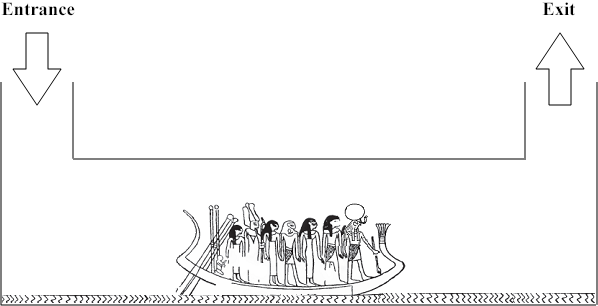 They enter and leave the netherworld in a systematic way, from two common places. The netherworld journey is about the spirit of the sun, the dead sun god, not about the sun's disk, and since the god and his followers are all in the same boat, they must have two common places for entering and leaving the netherworld. The Entrance was in a district of Heliopolis that was called, the Land of Life, and the Exit was in Amenta, the hidden land.
Table of Contents2. Osiris, Fountain of the Sun, and Netherworld Journey 3. Redefining a Hieroglyphic Symbol 4. The Sun Sets in the Land of Life 5. Amenta, The Hidden Land, Is Siwa Oasis 6. Bakhau is the Mountain of the Dead in Siwa Oasis 7. Fountain of the Sun of Siwa Oasis 8. Fountain of the Sun and the Moon
Nothing is left from the Egyptian religion except names of gods, hymns and ritual texts, but no complete story of anything. The basics of the religion and how the ancient Egyptians used to practice it is still a mystery. Most ideas we read about the Egyptian religion are no more than speculations and interpretations, but no absolute facts. Some interpreters give us the evidence that supports their views, while others don't, leaving us wondering about the basis of the given opinion. However the basic ideas of the religion are clear. According to texts and pictures, the religion is about life after death. The god Ra (the sun) comes everyday after sunset to the netherworld and takes with him in his boat his followers who died that day to the place where they are judged in the Judgment Hall of Osiris, the king of the dead.  Judgment Hall of Osiris -- Anubis is weighing the heart of
the deceased against the feather of Maat (the feather of
truth)
 1.
The boat of Ra arriving at the fountain of the sun of
Amenta, and the baby Horus is born
2. The sun, Ra, is born
"Heliopolis contained the earthly proxy
of the tree of heaven, the holy Persea, and the
sacred well which to
this day is called "the Sun's Well" ('Ain Shams) and in which the sun
was believed either to bathe himself morning and night or to have been
born at the beginning of the world, when he arose from the abyss."
(W. Max Muller, The Mythology of All Races, Vol.12, p.31)
It is not mentioned in the reference book of the quote above the basis of these assumptions, to bathe himself morning and night or to have been born at the beginning of the world, so we cannot discuss them in any way.
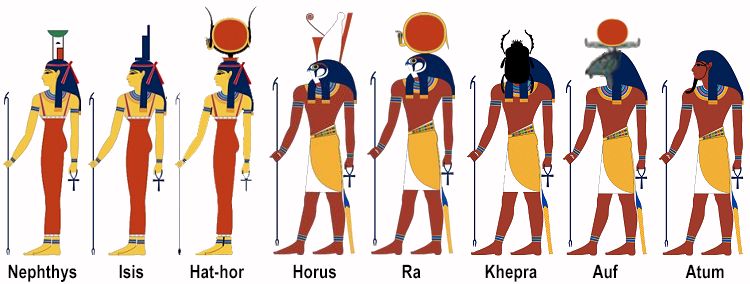 Egyptian Gods and Goddess -- Horus and Ra look exactly the same,
but the emblem is different; the same is true for the three
goddess, Nephthys, Isis and Hathor, can be identified by the
emblem on their heads. Ra, Khepra, Auf, and Atum (or Temu) are images
of the god Ra; Ra means sun.
Egyptian hieroglyphics do not indicate vowel sounds, so the pronunciation of
words are approximate; for example the name of the god Amun is written with
three characters AMN
The picture above shows the dead sun god after he left the sun's disk, he is shown in the form of the god Temu between the hands of Nut. The boat of Ra is shown at the right side. The boat has two lotus flowers, one at the front end of the boat, and the other at the rear; the meaning of these two flowers is explained in the pictures below.
The picture to the left above shows the sun symbol entering from one lotus flower and getting out from the second flower. The standing lady is Isis and the man who is lying down is Osiris; they are identified by their logos; the logo at the left is of Isis, and the other is of Osiris.
The picture to the right above shows Osiris coming out from the second flower. The natural explanation now is to say that Osiris must have entered from the first flower; he came from one place, used a boat as a transportation device, and then he came out in the second place from the second lotus flower. This idea is illustrated in the opposite picture that shows the head of a man at the rear and at the front of the sun boat. Some may think the two heads in the picture are of two different persons. This is the impression that we get at the first glance. But this is just the same as the sun symbol in the picture above, entering from one side and getting out from the other side; the sky has only one sun; so this head has to be of the same person.
Now what is this colorful building shown in the opposite picture? This is Rastau (or Restau), a complex imaginary underground structure that has many sections, gates and lakes. The upper part of it that is shown with vertical lines is the fountain of the sun. Everything below the vertical lines is imaginary, and it contains many evil things that the deceased has to pass in order to continue the netherworld journey with the god Ra. In the Book of the Dead of Peter Renouf, the author described Rastau as a gate between the netherworld and heaven. We will come back to Rastau later, and we will see what the author has written about it. It seems that the Egyptian religion is based on the story of Osiris and his brother Set. Here is the story as it is written in a book issued by the British Museum.
Some hints to the story of Osiris can be found in the Egyptian literature: "Asar... He was drowned in the Nile by Set and suffered mutilation, but he rose from the dead, and having been declared by the gods innocent of the charges brought against him by Set, became King of the Dead and giver of immortality to all who believed in him." (Budge, Dictionary, Vol.1, p.83)
From the story of Osiris and his brother Set we see that the dead body of Osiris was found in the Delta (Heliopolis) after he was killed, and then he was appointed as a king of the dead in Amenti (Ament, Amentet, Amenta). And based on the pictures that we have already seen, we can say that he was transferred from the Delta (Heliopolis) to Amenta in the sun boat; and the picture that shows his head coming out from the second lotus flower in the boat is actually about his night journey with the sun god from the Delta to Amenta.
The Book of the Dead speaks about a battle happened in Heliopolis -- Based on the context of the texts below, and on the story of Osiris, we can say that the battle happened on the night when Osiris was transferred from Heliopolis to Amenta: (1) "Hail, Thoth, who madest to be true the word of Osiris against his enemies, make thou the word of the scribe Nebseni to be true against his enemies, even as thou didst make the word of Osiris to be true against his enemies, in the presence of the Tchatcha Chiefs who are with Ra and Osiris in Anu [Heliopolis], on the night of the (things of the night), and the night of battle, and of the fettering of the Sebau fiends, and the day of the destruction of the enemies of Neb-er-tcher." (Budge, Book of the Dead, Vol.2, p.424) (2) "I am the Cat which fought near the Persea Tree in Anu (Heliopolis) on the night when the foes of Neb-er-tcher were destroyed. Who is this Cat? This male Cat is Ra himself..." (Budge, Book of the Dead, Vol.2, p.390).
We learn from the texts above that the Persea tree is in Heliopolis (2); and the Persea tree is in Rastau (3); this leads to a conclusion that the first Rastau is in Heliopolis, which is also the entrance gate and the starting point of the netherworld.
The netherworld journey and the battle with the snake and evil spirits is repeated everyday with every dead person traveling with the sun god from the Delta to Amenta, and it is also repeated with the sun god himself. And all of this is just a copy of the netherworld journey of Osiris with the sun god Ra. The picture above shows some examples; the man on the upper part of the picture is the scribe Ani, the author of the Papyrus of Ani; he first fought the snake Apep and then he rode the boat of Ra; the lady at the front of the boat is Isis, the same goddess who supervised the transfer of Osiris to Amenti. On the lower left of the picture is the sun god in the form of Tmu fighting the snake Apep, and on the lower right is the queen Nefertari standing on on the fountain of the sun.
A question may be asked, if this rounded object is open from the top, how could they stand on it without falling inside? They are spirits anyway, without weight, and this could be the reason for showing the spirits stand or sit on it; but there are also drawings showing them standing at the edge or coming out from the top (the two pictures to the right are examples). To avoid confusion, we have to take everything into account, texts and pictures, before making any conclusion. Below is a copy of the comment of Sir Peter Renouf on Rastau from his book, Book of the Dead:
The plates VI,11 and VII b mentioned in the quote above are those shown to the right. In both of these two plates the sun god is leaving the netherworld from Rastau. Now we have to understand that if we evaluate things independently, as separate things, we will not make any progress, we will be lost, but only if we deal with them as a combination, and one explains the other, then we can see the different parts that make up the story; and this includes texts and pictures. In the Egyptian Hieroglyphic Dictionary of Wallis Budge, Rastau is mentioned under many different words; below are some examples:
The text above talks about heat somewhere in Rastau. Ancient Greek historians have written that the fountain of the sun of Siwa Oasis was boiling hot at midnight. The idea behind the text above could have been based on the hot water of the fountain at midnight. "The water of this stream is lukewarm at early dawn; at the time when the market fills it is much cooler; by noon it has grown quite cold; at this time, therefore, they water their gardens. As the afternoon advances the coldness goes off, till, about sunset, the water is once more lukewarm; still the heat increases, and at midnight it boils furiously. After this time it again begins to cool, and grows less and less hot till morning comes. This spring is called the
From Budge's dictionary and other texts we can say now that Rastau has many different sections. In the quote above the dead man says that he is born in Rastau. Pictures show people born from lotus flowers. So the lotus flowers must be somewhere in Rastau, and we should put the lotus flowers in the upper part of it, in the place where they are supposed to be. Rastau is also a gate between the netherworld and heaven, so the sun god must be entering and leaving the netherworld from Rastau. And if we continue collecting the attributes of Rastau in this way, without ignoring anything at all, we will have a clear idea about it, and a better understanding of the Egyptian religion.  A group of gods and people born from Lotus flowers, in
Rastau (from the quote above: I am he who is born in Rastau).
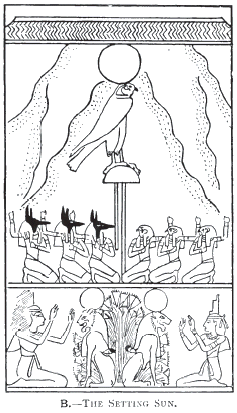 (Renouf, Book of the Dead, Plate V) The twin lion Aker is shown in blocks (5a, 8a and 1b). His function is to open the earth's gate; QUOTE: "Aker opens the earth�s gate for the king to pass into the Underworld." (George Hart, The Routledge Dictionary of Egyptian Gods and Goddesses, 2nd Ed., p.10) The earth's gate is the gate between the netherworld and heaven, Rastau. The picture to the right shows the two lions in a different representation, with lotus flowers in between; but the scene is basically the same as shown in the previous picture.
Sometimes they draw Rastau as a part of the boat of Ra; some other times it is replaced with a lotus flower; but neither Rastau nor the flower are physically part of the boat; and the drawings are just for showing how the dead come out from the netherworld, and how the boat and the netherworld are related to it.
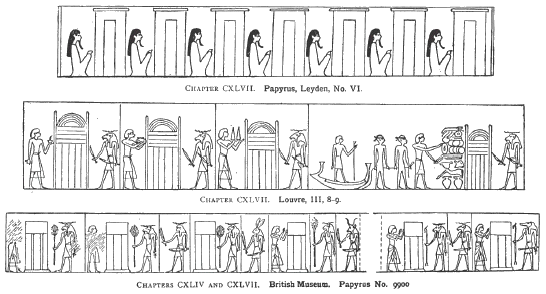 Internal gates inside Rastau (Peter Renouf, Book of the Dead, Ch.cxlvii, p.296 - 298)
 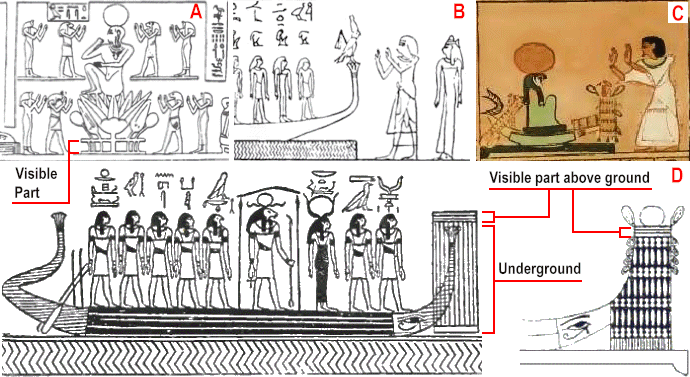 See block C and D in the picture above; in block D the Sun is coming out from a cylindrical object, and in block C a person is coming out from the same object; and this shows that there is no difference between the god and his followers in the way they enter and leave the netherworld.
 By looking at the color pictures above, we can see that the curved object where the two men are standing is very similar to a well of water, with an outer edge that is just above their feet. The difference between a fountain and a well of water is that the well has its water contained inside, whereas the water of the fountain flows to the outside. If you don't make a special arrangement for the water coming out of the fountain, it will fill its surroundings, and you will not be able to come close to the source. The curve makes the water flow in a stream, like the simplified drawing to the right. Shape D in the picture above is the top part of Rastau that we have already seen a previous picture. Notice the raised edges; and this shows that Rastau is nothing but the fountain of the sun.
If we look now at the above shapes all together, we will come up with a conclusion that is different from looking at one shape only. For example, if you look at shape A, you may think the sun enters a room or a house. And if you look at the color pictures and picture E, you may think that the curved object is a well of water, with a vessel of water at the right and another vessel at the left.
But if you look at the picture of the lions only, and nothing else, you may get confused, and then you may think the curved object is a mountain, assuming that the ancient Egyptians 5000 years ago thought of the Sun to set in mountains. And if someone who has no idea at all about the Egyptian religion might think of the lions as they are in a show, playing with a ball, and the lady is the lions trainer! Different people get different conclusions when they look at an issue from one angle only.
The curved object between the two lions is nothing but the same curved object shown in the other pictures above; it is the same curved object that looks like a well of water with men standing nearby.  Same place, same lions, but different views
 Fountain of the Sun Now this symbol
Let's see now an example of the symbol that is incorrectly interpreted to mean mountain.
The first term above also shows two rectangular symbols, one above the other (on the right side above). And this means they are equivalent to the curved symbols.
Elsewhere in the dictionary, Wallis Budge defines the rectangular symbol to mean stone; regardless whether of a mountain rock or not. Maybe stone or maybe not, one word can have different meanings, and the translation depends on the context of the text, just like translations of modern languages; if you don't know what the text is about, you may use wrong words; and then the translated text may not make sense with the wrong words; so you may think of inserting additional words from your mind to make the overall text make sense; and if you do so, you may end up destroying the meaning of the original text completely. This kind of text corruption happens in translations of modern and active languages, so it shouldn't be a surprise if it happens in translations from obsolete languages.
The picture to the right magnifies the two rectangular symbols, one above the other, and the symbol of water can be seen clearly inside, instead of lines in the small rectangles. The second definition from the dictionary above, that says: "the two mountains between which the deceased emerges" is explained in the picture below; the standing man is a deceased; the blue man is the god of primeval water, Nun -- the primeval water is simply the muddy water where lotus flowers grow. Now compare the man in lotus (above) and the object where the lotus is planted, to these rectangular objects, and you will see that the rectangular object is the same.
The two red highlighted rectangles in the
picture to the right, which is part of the picture above, look the same as the ones we have seen in the
definition of the term Tui,
and they are supposed
to be equivalent to the curved symbol
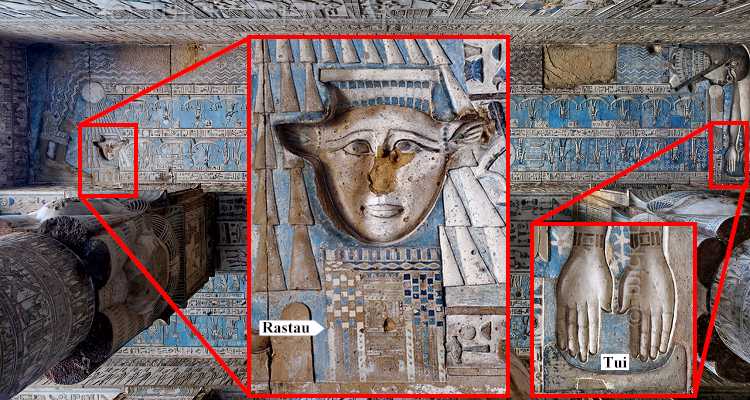
The sky goddess Nut from the Temple of Hathor at Dendera
Below are links to the original pictures from which the picture
of Nut above was constructed: In the picture above the supposed mountain (Tui) is shown on one side, and Rastau is shown on the other side of Nut. 
These four curved objects are exactly the same thing.
The B/W picture above shows Tui on the left side of Nut, on the opposite side of Tui in the previous picture! In the picture to the right above, the flower is open toward the scribe Ani; this indicates that Ani was ejected from the curved object by the flower. The two sticks on each side of the curved object are equivalent to the two trees on the curved object under Nut. Below are the two pictures of Hathor shown side by side for comparison purpose.
The born goddess is Hathor in both pictures, and both of them are from the same temple of Hathor at Dendera. One picture shows Tui and the other shows Rastau. The point is that these two things (Rastau and Tui) are the same thing, and can be demonstrated interchangeably. They are the same as the blue water boxes that we have already seen. The only difference between Rastau and Tui is that Rastau is an imaginary structure of the fountain of the sun, whereas Tui is the visible part of it. "I am he who is born in Restau." (Renouf, p.206) -- we have already seen this quote in full earlier. The picture of Hathor above reflects this quote very well. Below is a link to the original picture of Hathor to the right above:
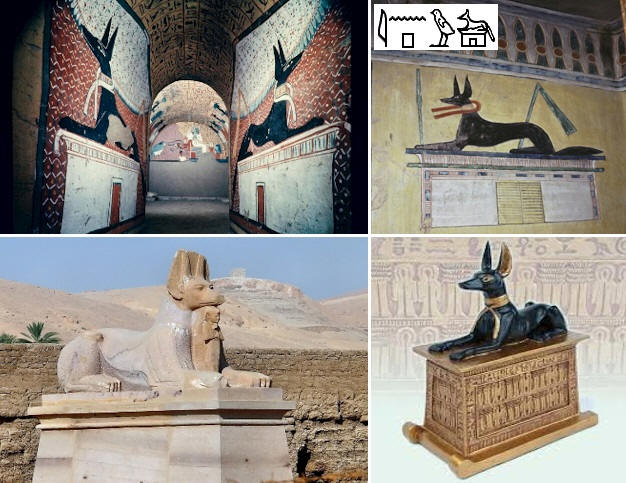 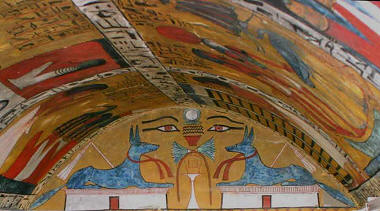 Anubis (Budge, Book of the Dead, Vol.2, Ch.137A, p.662) Below is the original text; the curved symbol and the rectangular
symbol are drawn together. Anubis is usually drawn sitting on Rastau or on a rectangular coffin, but not on a mountain! If his title is the one upon his mountain, some paintings should show him in that scene, but nothing could be found. Misinterpretation of one very important symbol led to countless mistakes, and also led to the misunderstanding of the entire Egyptian religion. Anubis is not only a protector of tombs, as described in many contemporary writings, but also protecting the souls entering or leaving Rastau. However, he is not protecting Rastau or tombs by directly sitting on them as shown in paintings, but providing spiritual protection in one way or another; otherwise he cannot be present in many different locations at the same time.
Anubis (Anpu) is also associated with Rastau, so he is drawn with it in various forms, including his symbol:
If we compare now the symbol of Anubis above, with the text we saw
earlier, that says "upon his mountain", the given symbols have to
mean the same thing; here is the text again:
The dead enter the netherworld from Rastau, not from a mountain, so
the text about Anubis should read: the one upon Since the curve in this symbol
What is the difference between these two
symbols
As mentioned in the summary, the two symbols are the same, but when the text
is about the god Ra entering or leaving the fountain of the sun, they draw the
god's symbol, the circle ʘ, on top of the curved symbol
Example: 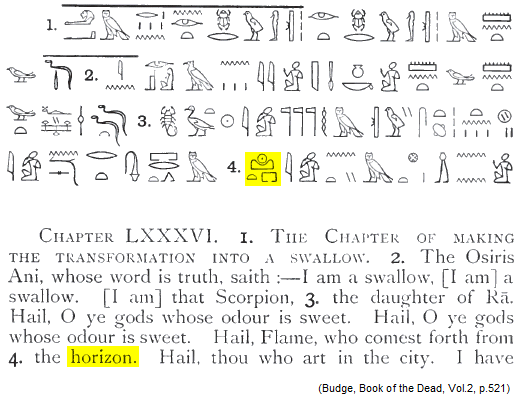 From the pictured quote above we cannot tell for sure who is
meant in the text to come forth from the horizon
The phrase in the quote above that Budge translated to "the eastern part of the sky" can be translated to "the eastern horizon of heaven;" it is exactly the same as the phrase used about the god. The following text uses the same expression, but translated to the eastern horizon:
Note that this symbol
The quote about Ani above says "the Ba-soul of Osiris Ani..." This is a clear
statement showing that this thing
In most phrases, this symbol
That means that this symbol
Sometimes this symbol
The semicircle
When it is followed by the symbol of the East
Since the symbol
The "eastern gate" does not have to be located in the east; it could be a
gate leading to the east. The same is true for the "western gate;" it is a gate
leading to the west. In a two pictured quotes we saw earlier in this section there are two
phrases describing this symbol
The following quote is from the closing text of the short version of Amduat (the Egyptian netherworld).
The last line in the quote above clearly says that the course of the god Ra was in the west only. Since the entire journey of the netherworld is in the west, the gate of the east must be in the west. The god comes out from the netherworld in the west, and then he flies from there using a boat to the eastern part of the sky, where the goddess Nut gives birth to the sun's disk. 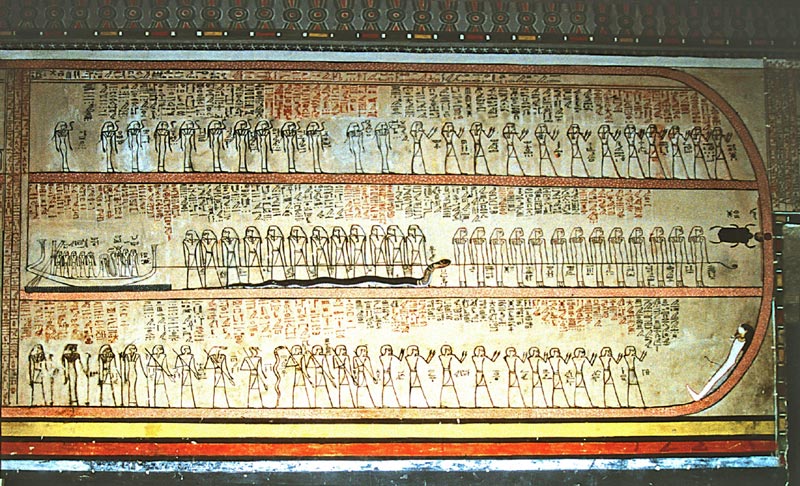 The netherworld journey ends in the place of Osiris, in the west of the Nile. The picture above agrees with the previous quote. It is about the 12th hour, the last hour, of the netherworld journey. The sun god leaves the netherworld in the form of a scarab beetle, shown in the picture in the middle register (or level). The man to the right in the lower register is Osiris. The people who are raising their arms in adoration to him are the dead who came with the sun god. All of this leads to a conclusion that the terms "eastern gate" and "western gate" are not physically located in the east and the west, but leading to the east and the west. By the end of the 12th hour, the last hour, the god flies to the sun's disk using a boat:
The previous quote is about the left upper portion of the picture above. The boat of Ra mentioned in the quote is shown under the body of the sky goddess Nut. The god Ra himself is shown in the form of a flying scarab, to mean that he is still a spirit; his body is the sun's disk, and now he is uniting with his body. By the end of the day, the sky goddess swallows the sun's disk, the spirit of the disk, the spirit of the god Ra, joins the spirits of other deities that are shown in the boat and they come all together to the netherworld.
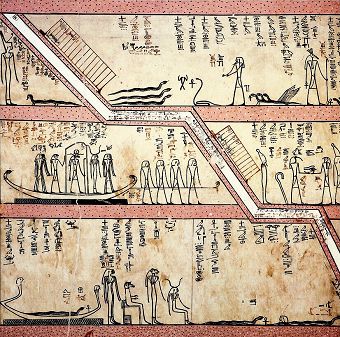 A picture
of a corridor from the 4th hour of Amduat
Rastau in the book of Amduat is mentioned in the forth hour, in phrases like: The mysterious ways of Rastau, going on the ways of Rastau. In addition to these phrases, a picture of a corridor is shown, which is the one in the picture to the right. These phrases and the picture of a corridor may give the impression that Rastau is a corridor in a building, and because of this, many writings in web pages assume Rastau is a corridor. The main book of the Egyptian religion is the Book of the Dead. Any other literature, such as Amduat, pyramid texts and coffin texts, must be understood in the context of the Book of the Dead. The book of Amduat doesn't say anything about the dead people who travel with Ra in the netherworld, but the Book of the Dead says that they travel with him, plus pictures showing them all together in the same boat. If we rely only on the Book of Amduat to understand the Egyptian religion, we will end up with wrong conclusions. 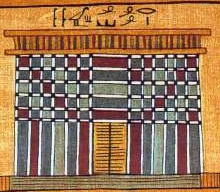 Rastau
The Book of the Dead says that Rastau is a gate between the netherworld and heaven. The picture of it shows it as a building with an entrance. And from other pictures that we have already seen, we knew that it is open from the top. The symbols above the building in the picture are the characters that make up the name, Rastau. Regarding the Book of Amduat, if we read it carefully, we see in one line that Rastau is a gate, not a corridor:
The underlined symbols in the pictured quote above have two slashes \\, which means that the number of the divine gates is two (i.e. two Rastaus). So the corridor basically is the ways that lead to the destination Rastau. These ways are secret. Some of the dead may get trapped there and lose their way to Rastau.
The pictured quote above must be about the picture to the right. This picture
is from the Book of the Dead, whereas the quote is from the book of Amduat. The last line in the quote says "at the eastern
gateway of the horizon." The word gateway
The sketch above shows the idea of the two fountains. Both fountains have the same name, the fountain of the sun. The one at Heliopolis leads to Amentet, the land to the west of the Nile, so they call the door that is at the bottom of it the gate of Amentet. The door of the other fountain leads to the east of the sky, so they call it the eastern gate. The pictured quote below confirms this conclusion:
The dead person (the scribe Ani) in the quote is wishing to arrive in peace in Amentet. So he must have started from somewhere else to finally arrive in Amentet, the place where Osiris was established as the king of the dead. More on this point in the following two sections.
It is thought that the Sun (Ra) sets in a mountain called Manu. But this doesn't agree with the text: "Adoration to Tmu as he setteth in the
As we have seen earlier the sun's disk doesn't set anywhere on earth, but swallowed by the sky goddess. So the quote above must be about the spirit of the sun's disk, in the form of Tmu, he sets in the Land of Life, and united to his mother (the sky goddess Nut) in Manu. It seems that Manu is the western horizon or an area somewhere in the west of the ancient Egypt.
The picture to the right is a copy from Budge's dictionary; it is about a place called "Ta en ankh", and means Land of Life; Ta means land; ankh means Life. Budge defines it as a district of Heliopolis. We have already seen that the first Rastau is in Heliopolis. This place, the land of life, must be the one meant in the text above. Notice that they say "set" and not "enter" when they actually talk about the god entering the netherworld! A dead man coming from the Land of Life: "I have come today from the land of life" (Rune Nyord, Breathing Flesh: Conceptions of the Body in the Ancient Egyptian Coffin Texts, p.355); The author, Rune Nyord, commented on the phrase Land of Life in the quote above and said "is regarded as the point of origin, and not destination." The destination is Amentet.
Amenti
Amenta is mentioned in many places in the Egyptian literature, and described as a beautiful place, the place where the dead live, and Osiris is the Lord of Amenta. The Egyptian religion was a mysterious, secret religion; only high priests knew the details of it; and because of this they wanted the land of the dead to be hidden, secret land. The Greek historian Plutarch wrote the story of Osiris, and he wrote that Osiris was established as the king of Amenti, but he doesn't seem to know where Amenti is. Ancient Greek and Roman officials used to visit Siwa Oasis for future prophecies or predictions in the temple of Amun-Ra, but most likely they knew very little about the Egyptian religion itself.
The picture above contains definitions from Budge's Dictionary; one for Amentet and the other for Ta Amentet. Not much in these definitions but they tell us that it is the abode of the dead and it is to the west of the Nile. 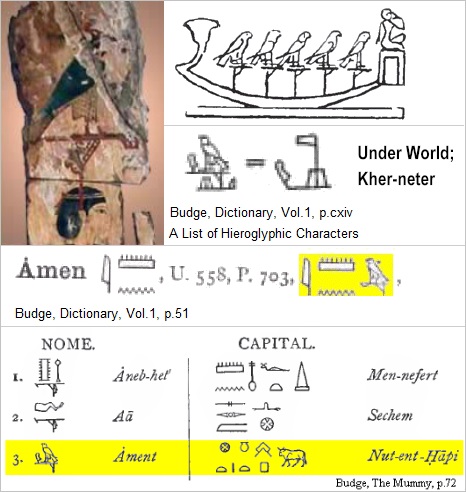 There was a nome (province) in ancient Egypt that has the name Ament, with the same emblem that is used for the netherworld (see the picture); and this indicates that the netherworld is a place on the earth and it is inside the borders of Egypt. The picture to the right shows that the capital of Nome Ament is Hapi; Hapi is Apis in Greek. Apis is shown in a blue circle on the Roman map below. According to Wikipedia, Apis was a seaport. Siwa Oasis is shown on the map in a red circle. Since we are looking for landmarks of a religion that started at least 5000 years ago, the map we have can be considered very recent relatively. Things must have gone major changes since the start of the religion. So it looks like the name Ament was given initially to Siwa Oasis, and after so many centuries the name Ament was applied to the whole desert west to the Nile, the Libyan Desert, and the seaport Apis has become the capital of the province Ament. However, regardless of the geographical changes, the religious belief must have remained the same, and Siwa Oasis must have remained Amenta, the hidden land, religiously.
In the book (Egyptian Mythology A to Z) the author described the goddess Ament, and wrote in a sentence: "From her home in the branches of a tree at the edge of the desert, Amentet watched for the souls as they approached the entrance to the Netherworld, or next world." (Pat Remler, Egyptian Mythology A to Z, 3rd Ed. p.10) It is not mentioned in the reference book above whether the given description is a translation of a hieroglyphic text, or based on interpretation of pictures only, but at least we have a source that agrees with what we have in this article. If you look now at the map above, you will see Siwa Oasis (the red circle) at the edge of the Egyptian desert.
The name Bakhau (Bakha, Bachau) is thought to be the mountain of sunrise in the east; just like thinking of Manu as the mountain of the sunset in the west; Bakhau and Manu are thought to be the most easterly and westerly points of the sun's course. Unlike Manu, Bakhau indeed is a mountain, but NOT in the east, in the west of the Nile.
The picture above is a copy from the dictionary of Wallis Budge. As you can see, the word bakh means "to give birth to"; and the word Bakhau is derived from the word bakh; this is confirmed by the pictured quote below. The meaning of birth is important because it lets us think about the birth of the god, instead of thinking about the rise of the sun's disk. 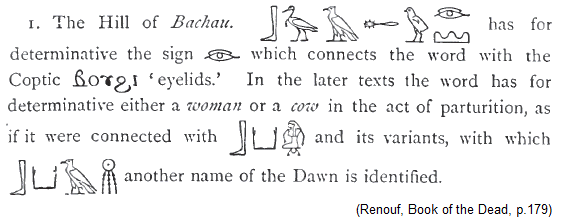 Based on the definitions we see here, Bakhau is clearly associated with the birth of the god Ra in the early morning, but that birth doesn't have to take place in the east, where the actual sun is seen rising in the morning. And since we are talking about a spirit, the spirit can fly to the disk at the speed of light from anywhere on Earth. There is a holy hill in Amenta, the land of the dead; QUOTE: "Homage to thee, O thou who dwellest in the Holy Hill (Set-Tchesert) of Amentet" (Budge, Book of the Dead, Vol.2, p.365) 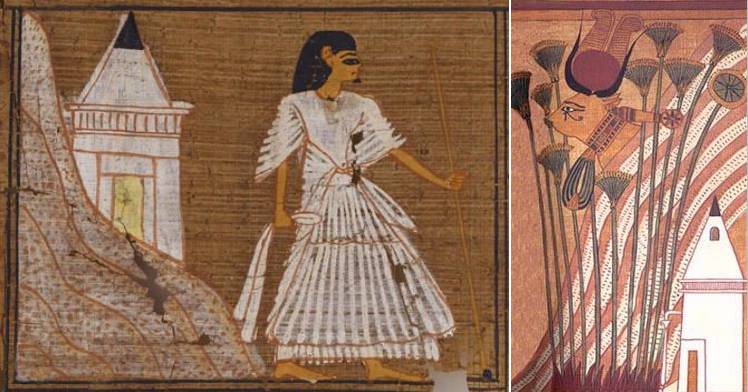
Left: Ani
is walking near the holy hill after he passed the trial
before the god Osiris
Right: Hathor is coming out of the holy hill
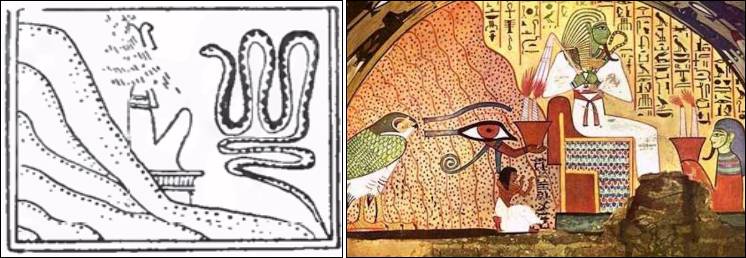
Left: Sebek or Sebak, a crocodile god, a form of Osiris
Right: Osiris is sitting in his temple on the Holy Hill of Amentet Osiris is the crocodile god: 
The word in the quote above that the author pronounced Amu, can also be
pronounced Am or Aam, and means palm tree
 Sebak
Anubis
This holy hill that Sebak is sitting on is the Hill of Bakhau, the assumed mountain of sunrise in the east. See the eye painted on the picture of the mountain, behind Osiris; it resembles the eye that is drawn with the symbols of Bakhau; shown below:
This symbol ( Notice that the mountain symbol
The following quote is about this hill, the hill of Bakhau: "In respect of the Hill of Bachau (i) upon which heaven resteth, it presenteth itself (2) three hundred cubits in length (3) and two hundred cubits in breadth. Sebak, the Lord of Bachau, is at the east of the Hill, and his temple is upon it. There is a serpent on the brow of that hill, five hundred cubits in length, three cubits of his forepart are pierced with swords." (Peter Page Renouf, Book of the Dead, Ch. cviii, p.178) Below are the dimensions of the hill from the quote above: Length: 300 cubits; about 160 meters (300 x 52.8 / 100 = 158.4) 1 cubit = 52.8 cm The author commented on the dimensions of the hill and wrote: "The earliest Papyri give the dimensions of both, but make the hill so absurdly small that the serpent could not rest upon it. Later papyri beginning with Pf have corrected the texts so as to give the hill a length of 300 cubits... The Papyrus of Nebseni gives the hill 300 cubits in breadth. The Totenbuch of Turin reads 370 in length, and 140 cubits in breadth." (Peter Renouf, Book of the Dead, p.180) There is a rocky hill in Siwa Oasis called Hill of the Dead, or Mountain of the Dead. Using wikimapia, we got the dimensions shown on the picture below.
As you can see, the width and length we found, they match, at least, one of the given numbers in the quote about Sebak or in the author comments. The ones who wrote the original texts did not agree on certain numbers anyway, so if we get numbers that match any of the given possibilities should be accepted, right?
The quote about Sebak talks about a snake sitting on the hill, "There is a serpent on the brow of that hill, five hundred cubits [260m] in length, three cubits of his forepart are pierced with swords." If you look now at the picture of the hill (right), you can see it rounded and naturally carved at the top. This rounded and carved shape could be the reason for them to believe in a big snake sitting there. The quote also says that Sebak has a temple on the eastern side of the Hill, "Sebak, the Lord of Bachau, is at the east of the Hill, and his temple is upon it." Sebak is the crocodile god, a form of Osiris, as we have seen before. There is no temple for Osiris in the Oasis now, but there are traces of one he had there.
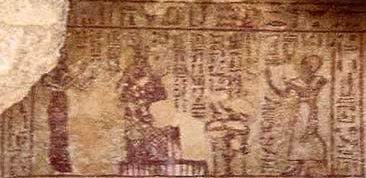 The Tomb of Niperpathot at Gebel (Jebel) al-Mawta in Siwa http://www.touregypt.net/featurestories/niperpathot.htm The picture to the right is of a tomb of a man on the Hill of the Dead, and from the link below the picture, we have this quote: "It belonged to a man whose chief title was 'Prophet of Osiris', and this shows that a temple for the god Osiris existed in the Oasis during his lifetime." We could not find where that temple was, but if the conclusions we are arriving at are correct, it should be on the eastern part of the Hill of the Dead. It might have been destroyed; or it might have been built inside the mountain like a cave, and now its entrance is blocked with rocks and sands. In any case, more information about it may exist in the oasis somewhere, but hasn't been discovered yet.
Because of his uncovered penis, he is described in contemporary writings as the god of fertility. The uncovered penis is not the only attribute that appears with him all the time, but there is also a cylindrical object behind him with a lotus flower on top of it. Most pictures show the lotus between two trees.
The object behind Amun-Min looks very similar to the one next to it in the picture above near the Persea tree of Heliopolis. In the picture to the right, the goddess Hathor is born from an object that has a tree on each site of it. The two trees almost identical to the ones that are on the object of Amun-Min.
The picture to the left above shows the god Ra, and the disk of the morning sun is on his head, meeting the dead queen Nefertari. The goddess sitting next to him and holding his arm is Ament, a goddess of the west. The other picture above shows the god Ra giving the ankh to a dead king, the disk of the morning sun is on his head, and the god Amun is sitting behind him. The Ankh is the symbol of life; the dead are awarded this symbol after they pass the trial before Osiris. All of this shows that the god Ra meets Amun and the dead people in the early morning, in the place where Amun and the dead people are, in the west of the Nile.
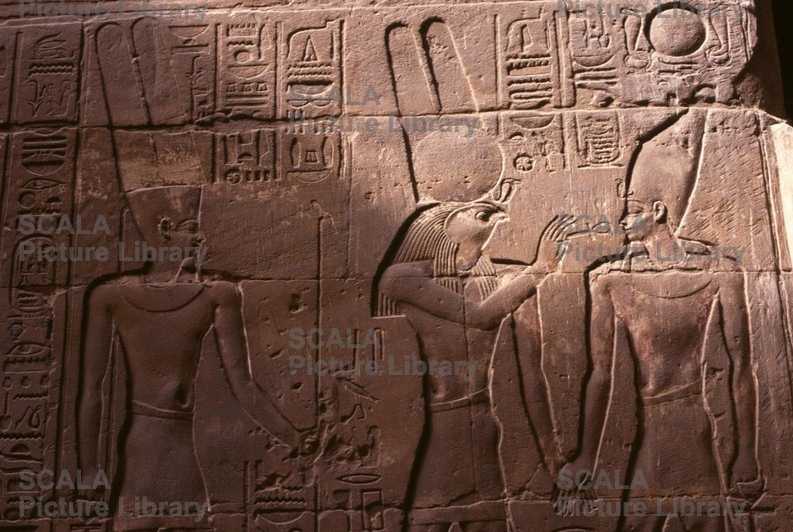 The morning sun giving the ankh to Alexander the Great, after his death, in the place where Amun is.
It is very logical to have all the dead, gods and people, to enter and leave the netherworld from the same points. The sun god in his night journey is dead; so why should he be excluded?
Many think that the so-called Cleopatra's Bath is actually the historical fountain of the sun. By looking at pictures of this bath (below), and comparing it to what is shown in paintings, the two things look completely different. 
Left: Cleopatra's Bath, Right: Fountain of the Sun as shown in Egyptian
paintings
Cleopatra's Bath doesn't only look different, but it is also located about one km away from the temple of Amun. A reference book on Google Books was found with information that agrees with the paintings and the location; the book suggests that it is similar to a well of water, and located a bout 37 meters only from the entrance of the temple:  "in the middle of the holy
precinct" and in the "immediate neighbourhood of the sanctuary"
(Annales Du Service Des Antiquites de L'Egypte, Volume 82, p.191, by The Supreme Council of Antiquities) The internet search for the suggested, the presumably, Holy Well, resulted in the photo below; from an Arabic web page about tourism in Siwa and about its history. 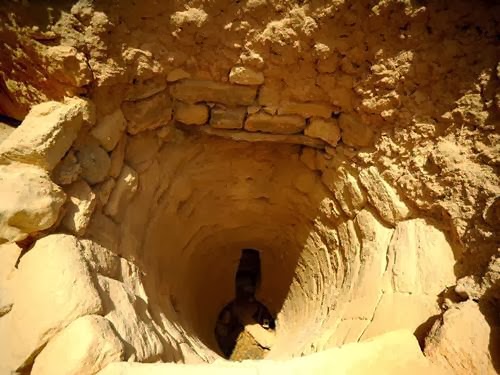
The Holy Well (The Fountain of the Sun) in the courtyard of Amun's Temple at Siwa Oasis
source: http://siwa-tourism.blogspot.com/2014/02/... A similar photo was also found on the following link: https://www.scubadiving.com/...
As mentioned in the summary section, extra rocks have been added to the
upper part of the fountain, maybe to prevent sand from falling inside, and that is why
the curve
Egyptologists who have interpreted this shape
The pictured quote below explains the idea behind the interpretation of this
symbol
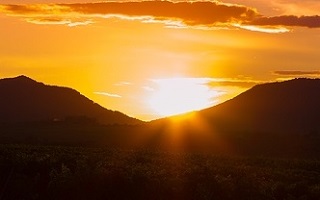 Sunrise between two mountain
peaks
According to the text above, this thing
Basically the interpretation of this symbol
When looking at the sun god coming out of a lotus flower, we have to assume that the flower is planted in muddy water. Mud doesn't come from under ground, but as a result of mixing a special type of soil with water. The second picture to the right above shows two vessels above the fountain; one of them contains a dark substance. This dark substance could be the mud required for the lotus flower. The other vessel also seems to contain a substance needed for the lotus flower. The third picture above shows the fountain's outer edge, and two women pouring the two substances inside the fountain. The substances reach the bottom of the fountain. As the time goes and the water flows, the mud comes out; so they do it again; and the process continues; and because it is a continuous process, they drew it like a circle. The internet search did not produce any result for the fountain of the sun that used to exist in ancient Heliopolis; but if excavations found it in the future, it should be just the same as the one in Siwa Oasis.
Full moon on top of a crescent moon is the symbol of the moon. Based on the moon's pictures, we can say that the moon uses Rastau to enter and exit from the netherworld. Ancient Egypt had two types of lotus flowers, but with a contradicting behavior; the blue water lily sinks under water at sunset and rises from water at dawn, while the white water lily sinks under water at dawn and rises from it at sunset. Maybe the moon uses the white water lily. Not much about the moon is in the book of the dead, except a few chapters of hymns to be recited on the first day of the moon. Maybe the moon enters the netherworld once in a month only. If we say the netherworld journey is a copy of the journey of Osiris, then what is the purpose of the journey of the moon? Since the starting and ending point of the moon's journey are the same as that of the sun, then it has to be related to Osiris by some means; however, the exact relation is not known. This is all we have to say about the moon and the fountain of the sun.
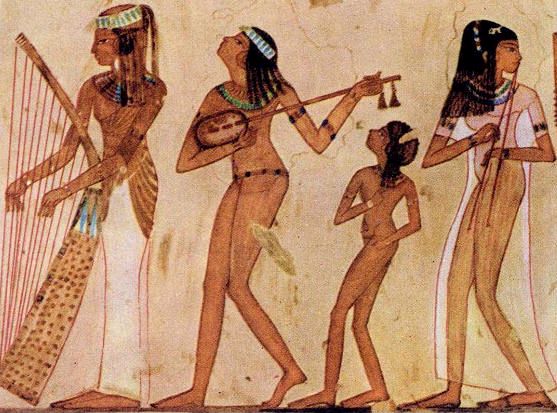 In the picture above, which is from the temple of Hathor at Dendera, the goddess Hathor, the daughter of Ra, is welcoming the rebirth of the dead. The one at the left side is her father Ra, and the other is Horus. But why is she naked? In other pictures from tomb paintings we see naked women dancing and playing music. What can be concluded from this is that the ancient Egyptians used to greet the rising lotus flower from water with music and nude dance; the rise of the flower is a sign signaling the rebirth of the dead. The story of this nudity goes to Hathor and her father Ra; QUOTE: "In the myth of the contest for power between Horus and SETH it is the goddess [Hathor] herself, 'lady of the southern sycamore', who cures her father Ra of a fit of sulking by dancing naked in front of him until he bursts into laughter." (George Hart, The Routledge Dictionary of Egyptian Gods and Goddesses, 2nd ed., p.65)
The picture to the right is a very simple sketch, but it
summarizes the whole night journey of the god Ra. The god enters the netherworld from a lotus
flower, and he comes out of it from another lotus flower; he uses a
boat as a transportation device. What applies to
the god, applies also to the dead people who travel with him in his
boat; and every dead person uses a separate lotus flower. The night
journey that every dead person goes through with the sun god is a copy of the
night journey of Osiris, from Heliopolis to Amenti.
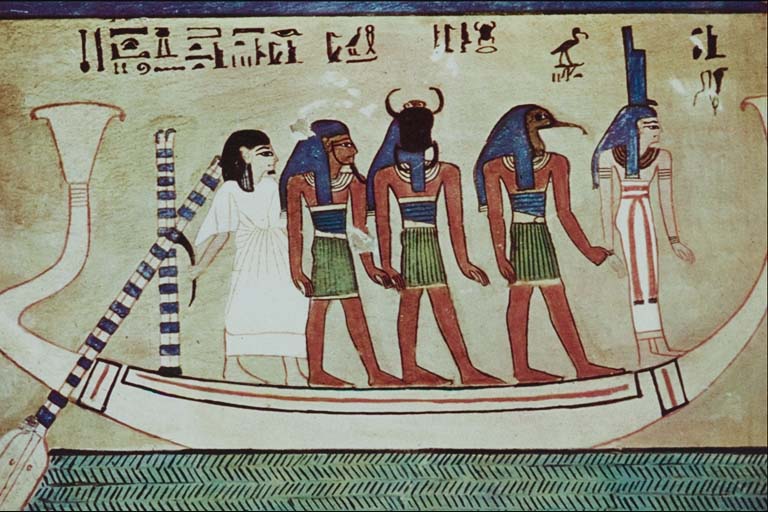
The man in the white clothes is the scribe Ani. The lady at the front of
the boat is Isis. The scarab-faced man is the sun god. They are now in
the underworld going to Amenti.
The fountain of the sun, the lotus flower, Heliopolis, and Amenta (Siwa Oasis), seem to be the most important components that make up the Egyptian religion. Ignoring any of them leads to the misunderstanding of the whole religion. ☼
 Same event, different representations; Isis and Nephthys greeting Ra at
dawn when he comes out of Rastau
 Same event, different representations; Aker opens the earth's gate
for the dead to pass into the netherworld; the earth's gate is Rastau,
it is the gate between the netherworld and heaven
 Rastau may be drawn
anywhere, even inside the
sun boat. This indicates a relation, and not a physical
location
 All the dead, gods and people, are welcomed with nude dance
(dancing for the rising lotus flower from water; the rise of
the flower is a sign signaling the rebirth of the dead)
 Dead gods and dead people come out from the netherworld in
the land of the dead; one place common for all, gods and
people
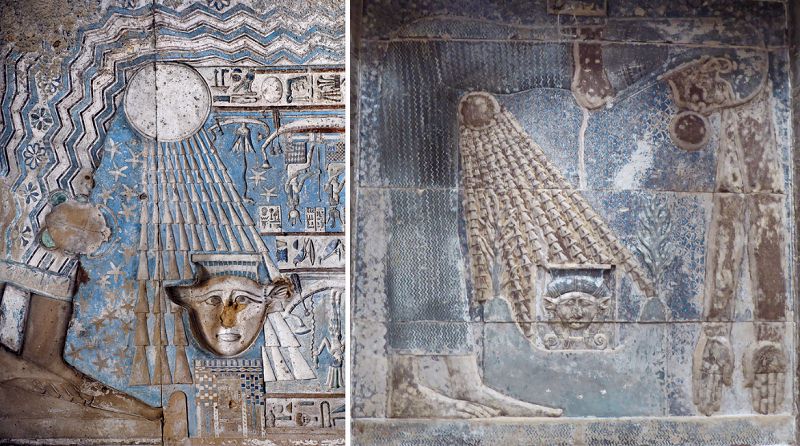 Rastau = Tui =
The Fountain of the
Sun
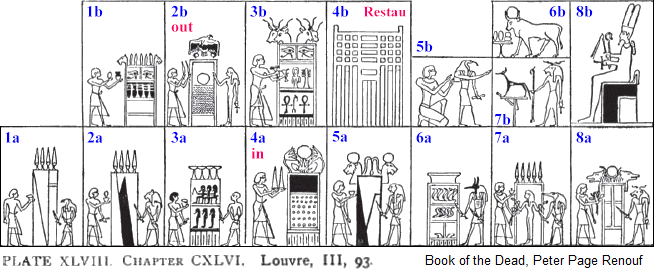
All in one
|
|||||||||||||||||||||||||||||||||||||||||||||||||||||||||||||||||||||||||||||||||||||||||||||||||||||||||||||||||||||||||||||||||||||||||||||||||||||||||||||||||